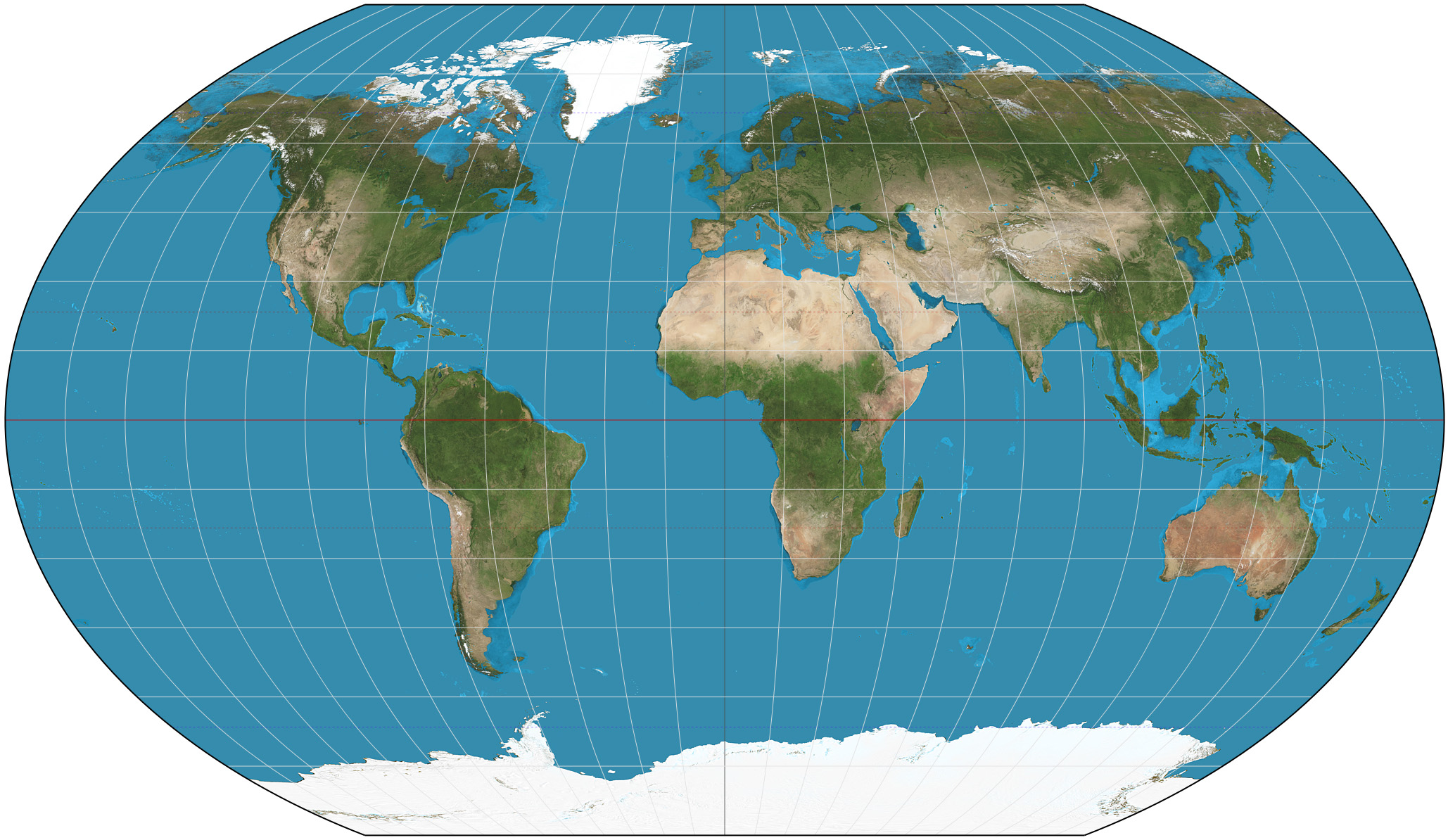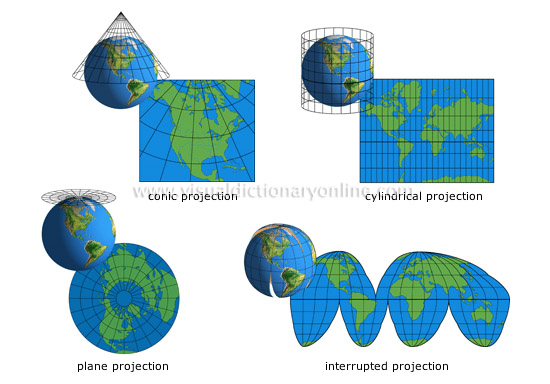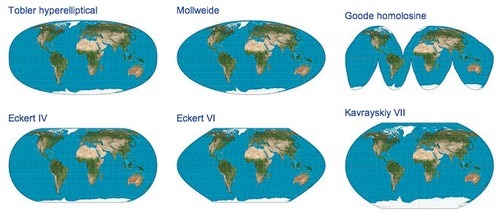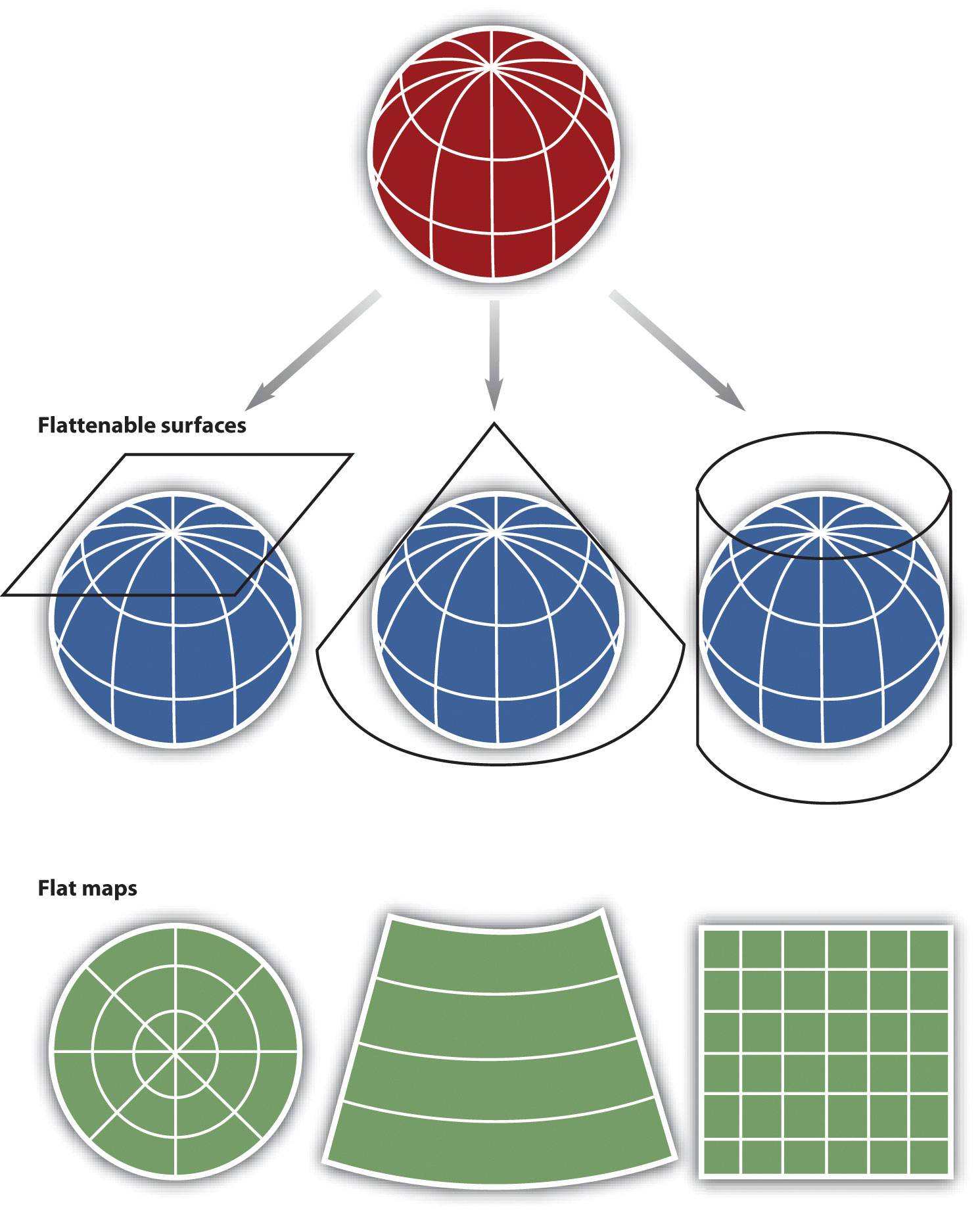Map projection
A card web design (also called map image ) is a method in cartography, with which one transfers the curved surface of the ( three-dimensional ) earth on the flat (two-dimensional ) map.
- 5.1 Length fidelity pictures
- 5.2 Equal area pictures
- 5.3 Conformal pictures
- 5.4 Mediating pictures
- 6.1 Spurious azimuthal pictures
- 6.2 Spurious cone pictures
- 6.3 Spurious cylinder pictures
- 6.4 Zerlappte networks
Procedure
The process of model building is done using mapping rules that can be expressed mathematically. Map projections can also explain vividly graphically or geometrically.
In the modern trend towards a spatial data infrastructure (technology and terminology) card network designs form a special class of coordinate reference systems and thereby provide a conversion method from a mathematical earth model in the plane dar. There are over 400 different known pictures.
When using Grid designs are basically three steps required:
Categories
Basically card network designs classified either according to
- Said imaging surface
- The position of the imaging surface
- The imaging characteristics ( distortion characteristics )
- Real or fake (pseudo ) illustrations.
Many network designs were named after their inventors.
Classification of imaging surfaces
Selection of the imaging surface
Most cards network designs are no projections in physical terms. They are based more on mathematical formulas. However, in order to understand the concept of map projection, it is helpful to think of a globe with a light source. This light source projects the points, lines and areas of the globe on the surface of an auxiliary body that can roll into the plane easily.
An auxiliary body can use one of a plane, a cone, a cylinder or a different body. By projecting the globe elements to this auxiliary surface one obtains a flat image. However, one must still roll with cone and cylinder before the surface in the plane. Basically, there are all map projections on the type of used auxiliary body.
Finally, it is important to know whether the auxiliary surface model touches the globe or cuts. For a cylindrical figure touches ( in normal position ) the imaging surface the globe around the equator (at this point there is no distortion ), while a cut cylinder intersects the globe at the northern and southern latitudes. The principle applies to all of Figure auxiliary surfaces.
Azimuthal pictures
An azimuthal figure touches the earth at one point. Many pictures are real perspective azimuthal projections ( central projections ), that is, they can also be constructed geometrically. This type of imaging is particularly suitable for representation of circular areas, such as the polar regions.
Gnomonic projection
Orthographic projection
The following geometric projections with a projection center are common:
- Stereographic projection, the conformal azimuthal image, wherein said center of projection is located opposite the point of contact. It is used, and others because of conformality for star maps.
- Called gnomonic projection, also called " central projection " (referring to here but at the center of the Earth ), in which the projection center is located in the center of the earth. It makes all great circles as straight lines from. Therefore, it is often used in the navigation to find the shortest route between two points.
- Orthographic Azimuthal, also called parallel projection in which the projection center lies at infinity, that is, the projection rays fall parallel on the globe. It is used for illustrative representation of the globe, and to display other celestial bodies ( moon, planets ), since it represents the celestial body as it would be in space to see ( from a distance ).
Lambert Azimuthal
More pictures are purely mathematically defined. You can not construct geometrically with ruler and compass in the rule. For this, they have special features that are not reached by the geometric projections. Find use mainly:
- Mitt distance loyalty Azimuthal, in which the distances are undistorted reproduced from center of map. It is used by eg radio services. The antenna is at the point of contact, and you can easily determine the direction and distance to his radio partner.
- Azimuthal Equal area by J. H. Lambert. It is inter alia used for atlas maps.
Cone pictures ( conical pictures )
For conic pictures ( conic projections ) the earth is mapped to a cone. The cone axis passing through the center of the earth. The position of the two cut or the Berührkreises determines the shape and position of the cone. Azimuthal and cylindrical images can be viewed as calculated on the formulas of the conical projection. Imagine as limiting cases of the general cone illustration dar. For cone in normal position:
- Length loyalty conic projection
- Lambert Conformal Conic ( compliant, ie angle-preserving )
- Albers conic projection ( equal area)
Loggerhead cone pictures
- Bonn ash projection (heart shape )
- Bar Wernersche projection (heart shape )
Cylinder pictures
Cylindrical projections are constructed with the aid of a cylinder around the earth.
- Mercator projection
- Area cylindrical projection or ( Gall ) Peters Projection
- Length-preserving projection cylinder, square planar map and rectangular planar map
- Miller cylindrical projection
- Lamberts area cylindrical projection
Furthermore, cylindrical projections (horizontal cylinder axis ) can be used when Gauss -Krüger and UTM coordinate system transversal.
Loggerhead cylinder pictures
Loggerhead cylinder pictures are mathematically constructed pictures, on which the central meridian and all parallels are straight lines.
- Mercator projection cylinder Sansonsche
- Mollweide by Carl Brandan Mollweide
- Goode projection ( cut-up card)
- Eckert II projection and Eckert IV projection and Eckert VI projection of Max Eckert Access Dorff
- Sinusoidal projection
- Pseudo - Wenz
Classification by position or aspect of the imaging surface
After the choice of the auxiliary body is established, must now be decided on its location. To describe one uses the Earth's axis and the mass line of the auxiliary body. At one level this is the vertical, for a cylinder centerline and at a bowling center line through the tip. The different imaging surfaces can be created at any point on the sphere surface. The choice of the location ( = aspect of the imaging surface ) is determined by the imaged portion of the surface for which the image is to be optimized:
- Normal pictures
- Transverse images
- Oblique images.
Classification of imaging characteristics ( distortion characteristics )
A map should accurately reflect the original as possible. When mapping the sphere to the plane, however, distortions are inevitable ( Mathematics: The Gaussian curvature is an invariant under isometries, the sphere of radius r has curvature 1 / r, the level, however, the curvature of 0, therefore there can be no isometry between two objects enter ). This phenomenon can be best thought of using an Orange: Even if you manage to peel it in one piece, you can see the shell ( surface) only with a strong push to get flat (paper) and takes into account distortions ( the shell expands, tears or folds ). This phenomenon of distortion can be justified differential geometric. To describe the local distortion characteristics at one point the Tissotsche indicatrix (distortion ellipse) is used.
Thus, the length of a line, the size and shape of a surface or the angle between two lines can change by the map projection. Consequently, the scale can vary on a map. A popular example is the almost gigantic representation of Greenland in the cylindrical projection. These distortions can never be completely eliminated. All map projections include at least one form of this distortion, so you have to decide for certain advantages and disadvantages among these imaging characteristics:
- Length-preserving ( equidistant ) image - some routes are correctly mapped ( for example, for distance measurements )
- Equal area (equivalent) image - all surfaces are shown to scale and correctly
- Angle-preserving ( conformal ) mapping (eg for navigation or for geodesy )
- Mediating distortion characteristics - compromise between length loyalty, fidelity surface or angle loyalty.
The length of fidelity can be achieved only limited in flat maps: in certain directions or at certain points. All pictures are real length faithful to the contact or cut circles. An absolute length consistency at all points and all directions is not possible. In conformal pictures the length distortion at a certain point in any direction ( azimuth) is the same.
The globe provides the ability to correctly reproduce almost all metric properties in a certain scale. Due to the very small scale reaches a sphere as an approximation of the earth's shape.
Length fidelity pictures
These images are not absolutely true to length, but leave only along lines other than the contact or intersection circles length-preserving measurements.
- Equirectangular and rectangular planar map ( equidistant cylinder pictures ) - along the meridians
- Mitt loyalty Azimuthal distance - from the center or along the radii
- Orthographic Azimuthal - along the circles around the point of contact
- Length loyalty conic projection
- Sinusoidal projection - along the parallels and the central meridian
- Werner Cordiform
Equal area pictures
These figures illustrate the size of an area (eg a continent ) dar. correctly The shape, however, can be greatly distorted. In particular, at the edge of the map, these images tend to be very distortions.
- Peters projection (cylindrical projection, also Gall- Peters projection or Gall- called projection )
- Albers conic projection
- Azimuthal Equal area after JH Lambert
- Mollweide by Carl Brandan Mollweide
- Hammer Aitov projection
- Briesemeister projection
- Sinusoidal projection
- Goodes projection ( cut-up cards)
Isogonality pictures
Conformal mappings are needed especially when navigating in shipping and air traffic for the creation of maps, but also in crystallography.
- Mercator projection
- Stereographic projection
- Lambert Conformal Conic
Mediating pictures
Since no map image distortions all completely cancels some mediating figures were developed as a compromise. In their attempts to minimize the distortion was.
- Kawraiski VII projection of Vladimir Kawraiski
- Robinson projection
- Van der Grinten projection
- Miller cylindrical projection
- Angle - Tripel projection
- (Also called Aitov -Wagner projection) Wagner IX projection
Spurious images (pseudo - pictures )
In normal situation remain the meridians straight lines which are circles of latitude as to rectangular concentric circles, arcs or straight lines shown in real pictures. All other figures fall into the group of fake bez. Pseudo - images.
Loggerhead azimuthal pictures
- Aitov projection 1889
- Hammer Planisphere ( equal area)
Loggerhead cone pictures
- Bonn ash projection, False cone illustration (heart shape )
- Bar Wernersche projection, False cone illustration (heart shape )
Loggerhead cylinder pictures
In contrast to the real cylinder pictures are pictures Meridian curved lines.
- Mollweide
- Eckert projection
- Sinusoidal projection
- Robinson projection
Zerlappte networks
- Goode projection ( cut-up card)
- Dymaxion projection
- Waterman World Map
- Cahill - Keyes map of the world
Figures in practice
- Swiss coordinates
- Gauss -Krüger coordinate system for Germany and Austria
- UTM coordinate system - Universal Transverse Mercator projection ( zone system spans the globe )










